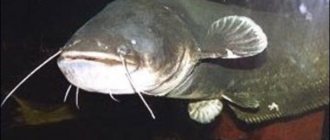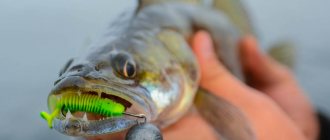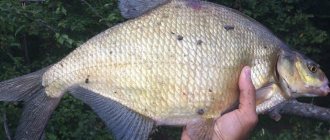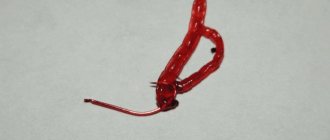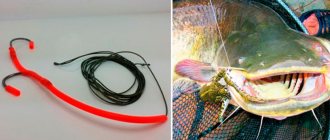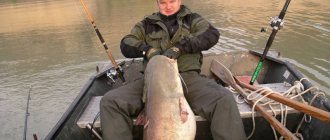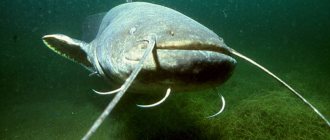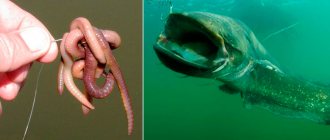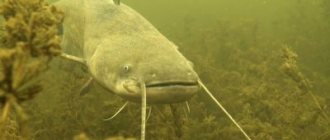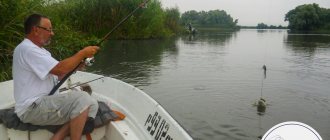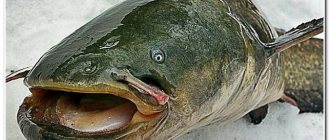3 859
- share 1
- share
- share
- share
- tweet
- share
Catfish is a very voracious predator; it is a heat-loving fish. Mid-summer is the peak feeding period for this fish. Therefore, July-August is the best time for catching catfish. This predator is not afraid of its neighbors; usually everyone is afraid of it. The most difficult moments in catching this predator is choosing a fishing spot, as well as the process of getting this river monster out of the water, because its size reaches incredible proportions.
Features of catfish behavior in August
Catfish in August are unpredictable, as is the weather this month. Namely, the behavior of catfish in August depends on the weather conditions. Temperatures in the first half of the month are consistently high. In extreme heat, large catfish stay in bottom recesses. Young individuals, weighing 2-4 kg, actively search for food during the day in the bottom horizons of reservoirs. Practice shows that they can become bycatch during targeted fishing for trophy crucian carp, which also predominantly feeds near the surface of the bottom.
After dusk, activity increases in large individuals. At night, they often appear in the coastal strip, where they hunt for frogs. At night, the probability of catching a catfish weighing more than 5 kg increases.
Features of catfish fishing in summer
Catfish are very lazy during the day and active at night. On a sunny day, he lies on pits digesting his victims. Sometimes it can rise to the surface of the water to take in air. This happens when there is a poor level of oxygen in the water. Don't try to catch it during the day. Better prepare your gear for the evening hunt. The classic bait for catfish is small live bait. It can be a white fish, a small predator, but a large worm is also used for fishing. Catfish also bite well on shells.
Where to look for catfish in August
When planning a targeted fishing trip, it is important to know where to look for catfish in August. The task is simplified with a fishing echo sounder, which allows for rapid exploration of the bottom. If the echo sounder model does not detect the presence of fish, then you should stop choosing a fishing spot in the deepest parts of the reservoir.
Promising signs of the presence of catfish are artificial structures or natural bottom shelters: flooded trees, large snags, depressions (pits) of various sizes, which are located away from the channel flow.
In August, catfish rarely move to other parts of the reservoir, but this does not mean that it is constantly located in one place. The lack of food forces the fish to search for food throughout the day. At night, freshwater giants can approach the shore or existing islands. Large individuals usually hunt alone.
The highest activity of catfish in August occurs in the dark. But if you choose a good place for fishing for catfish, you can catch it during the day. A voracious omnivorous predator will not miss the opportunity to feast on prey that comes under its nose.
Where to catch catfish?
Catfish have several characteristic and unchanging habitat features:
- They live in river holes that are not deep. Usually, close to the river flow.
- There may be several individuals in one shelter. If we are talking about a large, deep depression, then there can be up to several hundred catfish there.
- Catfish can also live near dams of large rivers, and in large numbers.
- Catfish prefer clean, transparent water; if the water is cloudy, the fish try to stay away from it. They go deep.
- Catfish often leave their habitat. He can stay in one place for a very long time. A predator emerges from its hiding place solely to hunt.
- Catfish have a predominant nocturnal lifestyle. The predator hunts at night and rests during the day. But in hot weather, catfish float closer to the surface, which allows fishing during the day.
You can determine the location of the catfish as follows:
- By bubbles in the water . Moving along the muddy bottom, the catfish touches it with its peritoneum, releasing air bubbles accumulated there to the surface. The fisherman should pay close attention to this, so it is better to fish in calm weather.
- By the splash. When swimming at shallow depths, the catfish makes a characteristic splashing sound.
- On the trail. Swimming along the surface, the catfish leaves behind a smooth water trail.
Catfish in August on the feeder
All types of gear that allow you to hold the bait near the surface of the bottom are suitable for catching catfish. The feeder is an improved donka, successfully used when catching catfish from the shore. A properly selected feeder rod allows you to cast 80 meters or more. It is important to pay special attention to the strength of the rod, because catfish weighing 10 kg or more are a bit of a rarity.
A high-quality spinning reel is installed. To prevent large fish from dragging the tackle from the stand, it is better to use reel models equipped with a baitrunner. The clutch must be adjusted correctly. It will ensure timely release of the cord when a critical load occurs that threatens to break the equipment.
The catfish feeder is equipped with a braided line that can withstand a breaking load of 20 kg. With such a cord you can feel more confident when landing large fish.
For catfish, durable types of fishing hooks No. 10-15 are used. The size of the hook is selected according to the dimensions of the expected catch.
The feeder feeder is filled with the crushed bait used, which is mixed with clay. To cast the bait to the required distance, attach a sinker whose weight corresponds to the rod test.
The fishing arsenal is filled with all available baits. What catfish bite on can be found here.
The casting is carried out with the expectation that the bait on the hook will hit the entrance (exit) in the detected bottom depression. According to this principle, the gear is installed in a fan. The optimal quantity is 3-4 tackles. If the coastline allows, it is advisable to place the rods nearby. The main thing is to avoid overlapping of rigs when fishing.
It is important to consider: in order to tire a catfish weighing 10-15 kg that has been hooked, it will take about half an hour.
Catching catfish in August using a feeder and other bottom gear is convenient because you can cast the gear before dark and expect a bite after daylight hours have passed. Bite alarms for night fishing can be bells, bells and special fireflies.
Catching catfish in summer. Fishing in August
The best time for catching catfish
The best time for catching catfish is July - August . It is especially well caught soon after spawning, which usually occurs at a temperature of +18-22 degrees Celsius. The best fishing time during the day should be considered from dusk to dawn. But even during the day, the possibility of his grip cannot be ruled out if the bait passes close to his mouth. Usually during the day it is caught in places where it is concentrated, for example, at dams on large “catfish” (Don) rivers. There are numerous cases of catching small catfish on the Oka, Klyazma and other rivers. This fish is caught only on calm and warm days. What does catfish eat?
The main food
of catfish is small, medium, and sometimes large fish. It also eats worms, mollusks, crayfish, waterfowl chicks, and can even grab a gaping adult duck. Green frogs are a delicacy for catfish. Tackle and attachments for catching catfish
Hunting for catfish requires special observation and very durable gear. In most cases, a millimeter nylon line with a tee No. 10-12 is sufficient. The best baits are medium-sized roaches, frogs or fried sparrows (catfish love the smell of burnt feathers or wool).
When catching catfish with a spinning rod, tackle with small fish, elongated white spoons and sinking wobblers are used as bait. The best time to hunt with a spinning rod is early morning and late evening. The most catchy places are shallows in front of pits and pools, in which catfish constantly live.
In deep holes where there is no current, catfish are caught using vertical lures. The lure on the fishing rod is narrow, large in size (8-10 cm) with a single or triple hook. Sometimes, to increase the weight, tin is soldered onto it. More often, the catfish grabs the spoon during smooth pulls or at the moment of damping of vibrations. The predator is also attracted by the spinner moving on the ground when it creates a slight turbidity.
When fishing with a bottom fishing rod, the bait must be lowered onto the ground in a pool or on a coastal shallow near a riffle, at the exit of a hole, at the mouth of a tributary. Live fish or frogs are used as bait.
Catching catfish using kwok is very productive. A kwok is a curved instrument made of wood or metal ending in a flat head. When it hits the water, the quok makes a gurgling sound that attracts catfish. It is more convenient to fish with a quok together. One angler controls the boat, the other manipulates the gear. The fishing tackle for quok consists of a strong cord on a reel with a heavy sinker attached to it. Near the sinker, a half-meter nylon leash with a large forged hook is tied to the cord. A large frog is put on the hook as a bait. It is necessary to direct the boat with the current and guide the bait through a deep place in the bottom layer. After a series of three strikes on the water with a quok, there is a pause of several seconds. If there is no bite, then the quok strikes are repeated to the right or to the left. Catfish can be found in holes and pools washed by the river in soft soil. There they settle down in groups of several fish and spend almost the entire day there. The opening of a catfish hole often occurs by accident. If, while fishing with live bait, you remove the tackle with a broken line as if broken by a blunt object, then this is a sure sign that a large catfish living nearby has become interested in the bait. Often the proximity of a catfish pit is indicated by the break of a strong bottom installed at night. The hole itself should almost certainly be looked for a little further downstream, because... this fish usually goes hunting against the current. Sometimes the search for catfish can be done visually. Young catfish can hunt during the day in the surface layer of water. It happens that a catfish paired with an asp hunts for small fish on the surface.
It is generally accepted that catfish are active at dusk and at night. This mainly applies to large catfish that weigh more than 30 kg. The vast majority of these fish are active throughout the day. With the onset of twilight, catfish move in the water column closer to the surface. You can often observe catfish hunting frogs.
Catching catfish on a donk
Bottom gear for catching catfish is used in places where these fish may emerge from pits and in places where they may accumulate. Catfish are usually caught with a bottom hook at night, placing it in the evening and checking it in the morning. The tackle usually consists of a strong cord ending with a leash 0.5-1.0 mm thick. Single hooks are used, size no less than No. 10, and when fishing in pits No. 35-40.
On the shore, the tackle is secured in such a way that it can absorb the jerks of the caught fish. This could be a peg made from a tree branch attached to the shore. There are also special branded rubber shock absorbers. A catfish caught with such gear is usually ready for fishing by morning and offers almost no resistance.
Catching catfish using a jigging rod
The zherlitsa should be secured to the shore as securely as possible, tying it to coastal trees. The butt stake is not used with such tackle; the catfish is too strong and will almost certainly vomit it. Large baitfish and frogs are used as bait. They are tied to a hook in such a way that they can move. Frogs are allowed to float on the surface so that neither the current nor the wind can entangle the tackle in algae or bottom support.
Catfish in August for spinning
Fans of active fishing successfully catch the freshwater giant using a spinning rod. Catching catfish in August using spinning rods is carried out from the shore and boat. The main requirement for gear is high strength.
When choosing spinning baits for catfish, you need to take into account its poor eyesight. Large (10 cm or more) baits are selected that perfectly imitate the behavior of small fish with a noise effect. The noise can be created by the position of the blade on the bait or the noise chamber built into it. Coloring doesn't really matter.
Spinning baits for catfish:
• Wobblers with built-in noise chambers. Suitable for fishing in promising habitat areas for August catfish and for trolling;
• Fast-sinking oscillating lures. Uniform wiring with alternating pauses is used. During the pause, you need to lightly “play” with the bait. This behavior usually attracts the catfish's attention;
What to catch?
In August, a variety of gear is used for catfish, each of them can become catchy if used correctly, among them:
- kwok;
- donks, including feeder;
- spinning rod for casting and trolling.
Kwok is an ancient tackle, described by the patriarch of Russian fishing L.P. Sabaneev, and today it occupies a leading position, if not in terms of mass numbers, then certainly in terms of the size of the trophies caught. It is a fishing rod with a strong cord, at the end of which there is a leader with a sinker and a large hook.
A separate element of the gear is the kwok itself - an instrument with which the fisherman in the boat strikes the surface of the water, creating a sound attractive to catfish.
Som in August for mugs
On a large reservoir, catfish fishing is used in August using mugs. To fish with this gear you will need a boat or other watercraft. The “circle” tackle can be purchased at a specialized store or made with your own hands:
• Cut a circle from floating material with a diameter of 15-20 cm. Thickness 2-5 cm;
• Make a recess at the end (about 1 cm wide) for laying the cord of the required length;
• A wooden antenna, about 20 cm high, is installed in the center of the circle, in a special cutout of which a cord is fixed;
• The equipment consists of a sinker and leashes with hooks.
Suitable bait is attached to the hooks and the gear is placed over the deepest places of the lake or river. Turning the circle over or clearly moving to the side indicates a bite.
Larger specimens are also caught on mugs:

